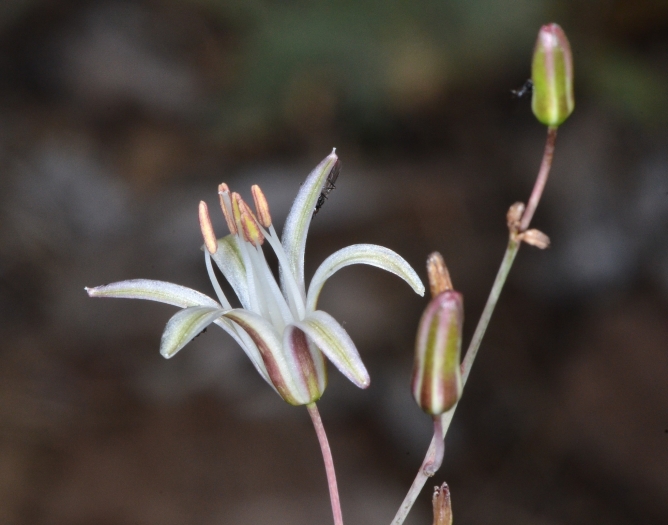Narrowleaf Soap Plant
(Chlorogalum angustifolium)
Narrowleaf Soap Plant (Chlorogalum angustifolium)
/
/

Don Loarie
CC BY 4.0
Image By:
Don Loarie
Recorded By:
Copyright:
CC BY 4.0
Copyright Notice:
Photo by: Don Loarie | License Type: CC BY 4.0 | License URL: http://creativecommons.org/licenses/by/4.0/ | Rights Holder: Don Loarie | Publisher: iNaturalist | Date Created: 2012-06-24T08:40:34-07:00 |








Estimated Native Range
Summary
Chlorogalum angustifolium, commonly known as the narrowleaf soap plant, is a perennial herb native to California’s chaparral and woodlands, including the Sierra Nevada foothills, inner North Coast Ranges, and extending into the southern Oregon mountains. It is adapted to a Mediterranean climate with wet winters and dry summers, often found in heavy, rocky soils on grassy hillsides and open woodlands. The plant typically grows from a fibrous bulb and produces a basal rosette of narrow leaves. During late spring to early summer, it sends up an inflorescence up to 27.5 inches long, bearing ephemeral, star-shaped flowers. Each flower has six white tepals with yellow-green midveins and is adorned with six stamens tipped with large yellow anthers. The flowers are particularly notable for opening in the evening and closing by the following morning.
The narrowleaf soap plant is valued for its drought tolerance and its unique flowering habit, making it an interesting addition to native plant gardens and xeriscapes. It requires minimal maintenance once established and can be used in restoration projects or as an ornamental in dry garden settings. It thrives in full sun to part shade and prefers well-drained soils. While it is not commonly afflicted by diseases, overwatering can lead to bulb rot. The plant has historical significance as the indigenous Karuk people utilized the soapy juice from the crushed bulbs as a detergent for washing clothing.CC BY-SA 4.0
The narrowleaf soap plant is valued for its drought tolerance and its unique flowering habit, making it an interesting addition to native plant gardens and xeriscapes. It requires minimal maintenance once established and can be used in restoration projects or as an ornamental in dry garden settings. It thrives in full sun to part shade and prefers well-drained soils. While it is not commonly afflicted by diseases, overwatering can lead to bulb rot. The plant has historical significance as the indigenous Karuk people utilized the soapy juice from the crushed bulbs as a detergent for washing clothing.CC BY-SA 4.0
Plant Description
- Plant Type: Herb, Bulb
- Height: 1-2 feet
- Width: 1-2 feet
- Growth Rate: Moderate
- Flower Color: Green, White
- Flowering Season: Spring, Summer
- Leaf Retention: Deciduous
Growth Requirements
- Sun: Full Sun, Part Shade
- Water: Low
- Drainage: Medium, Fast
Common Uses
Drought Tolerant, Low Maintenance
Natural Habitat
Native to California’s chaparral and woodlands, including the Sierra Nevada foothills, inner North Coast Ranges, and extending into the southern Oregon mountains
Other Names
Common Names: Amole
Scientific Names: , Chlorogalum angustifolium, Laothoe angustifolia,
GBIF Accepted Name: